Physics for Kids: What is Force?
Table of Contents
In the activities that we carry out on a daily basis, we apply forces. Although forces cannot be seen or touched, we know that they exist because of their effects.
In this article you’ll find out what force and movement are, explained easily for children. You’ll also learn how forces are represented, the characteristics of a vector and much more! Here’s Howforkids’ take on Force and Motion for Kids.
Introduction to Force and Motion
A force is any action capable of modifying the shape of an object, or of changing the state of rest or the movement of an object.

How to Measure Force
The unit of measure for force is the newton which is abbreviated as “N”. One newton is the force needed to accelerate one gram of mass by one centimeter per second squared.
Effects of Forces
The effects caused by the forces are used to identify them. If you pay attention to an object on which forces are exerted, you will observe only one effect. For example, we notice that the object moves, breaks or deforms.
1. Force can change the shape of an object.
2. Force can change the state of motion of an object.
3. Force can change the direction of moving objects.
4. Force can increase the speed of moving objects.
5. Force can slow down moving objects.
Forces deform objects or change their motion. And sometimes objects can break. Let’s explain what forces consist of.

What is Deformation? Definition and Types
Deformation is one of the effects of contact forces. Solid bodies are classified into two groups according to their behavior when a force is applied: Deformable and non-deformable.
Plastic and Elastic Deformation Facts for kids
Elasticity vs Plasticity
Deformable Solids
Deformable solids are those that deform when applying a force. They are classified into two groups:
• Plastic Body: They are deformed by the action of a force and do not recover their original shape when said force ceases to act. In this case the deformation is permanent and is said to be a plastic deformation. For example, when you crush a soda can, you knead wax, butter.
• Elastic Body: They are deformed by the action of a force but recover their original shape when the force ceases to act. Examples: elastic bands. The forces that cause a spring to return to its original shape are called elastic forces. Examples: rubber ball, bow arrow, fishing rod, taut guitar string, chewing gum.
Non-deformable solids (Rigid)
They are also called rigid solids. In some cases, if the force is very intense, the object can break, producing a fracture.
What is Hooke’s Law? Who was Robert Hooke
What does Hooke’s Law say? Law of Elasticity or Hooke’s Law:
Elastic objects are those that deform due to the action of a force but return to their original shape when the force ceases.
The English scientist Robert Hooke (1635-1703) studied the behavior of elastic objects that recover their shape after being deformed.
Hooke’s law states that the deformation of an elastic object is directly proportional to the force that has been exerted. The greater the force, the greater the deformation, and vice versa.
Hooke also invented the compound microscope which he used to look at the small world of microorganisms. He published a book called Micrographia with illustrations of 57 microscopic observations of minerals, vegetables (including the observation of cork structure) and animals. He is believed to be the first person to use the word cell.
Forces and Vectors
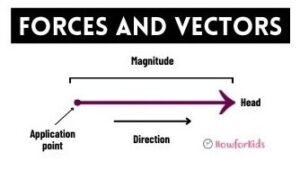
Since forces cannot be seen, how can we represent a force?
Forces are represented by arrows called vectors. This arrow or vector, which represents a force, indicates the following:
– With what orientation the force is applied.
– Where does it apply?
– Gives an idea of its intensity according to the length of the arrow.
Characteristics of a Vector for Kids
The vectors share common characteristics.
• Intensity/Magnitude: Indicated with the size/length of the vector. The longer the vector, the greater the intensity or amount of force applied to an object. The greater the intensity of the force, the longer the vector segment is drawn.
• Application point: It is the point of origin of the vector. Indicates the exact place where the force is applied.
• Direction: It is the imaginary straight line on which the force is applied and indicates where that force is directed. It can be vertical, horizontal or oblique.
• Sense: It marks the orientation in which the force is applied. It is represented by the arrowhead (for example, from top to bottom, left to right).
Addition and Subtraction of Forces
It is common for several forces to act on one object at the same time.
• When the forces have the same direction (the arrows point to the same side) they are added.
• If the forces have the opposite direction, they are subtracted.
• In all cases a new force is obtained which is called resultant.
• When the applied forces have the same intensity, the equilibrium state is produced and the object does not move.
• If the forces are opposite and have different intensity the object will move in the direction of the force of greater intensity.
Forces and Vectors: Explanation for children
Types of Forces
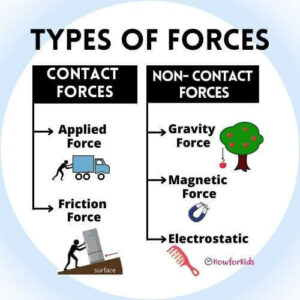
Not all forces act in the same way. In the different daily activities such as: riding a bicycle, playing ball, various forces are present.
Two types of forces can be distinguished, those that act when the bodies touch and those that act at a distance:
1. Contact Forces
They are those that are exercised when the bodies “touch”. The one who exerts the force touches the one who receives it. Like when you kick a ball, or even when you’re sitting on a chair.
2. Non – Contact Forces (Action at a Distance Forces)
They are those that act “from afar”, between objects that do not touch each other, that are at a certain distance. It is for example the force of gravity and the magnetic force. Let’s explain each one.
Gravity and Gravitational Force
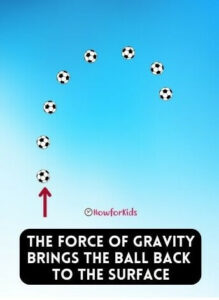
Gravity is a distance force that the Earth exerts on all objects towards the center of the planet, such as when the leaves fall from a tree. This force is responsible for all objects falling to the ground and not being suspended in the air.
Gravity allows the planets to revolve around the sun, and keeps the galaxies together. The first ideas about this phenomenon were proposed by Isaac Newton. The greater the mass of a body, the greater the force of attraction. (Newton’s Law of Universal Gravitation)
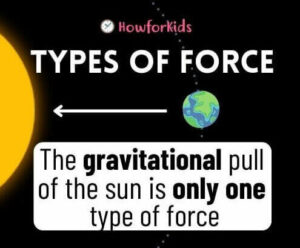
Magnetism and Magnetic Force
Magnets attract objects, even if they are some distance away. This force is called magnetism or magnetic force and is also a force at a distance.
The space where the magnet exerts its force is called the magnetic field. As the objects move away from the magnet, the attractive force decreases until it reaches a distance in which it cannot attract them. For example, a refrigerator door is kept closed by magnets.
What is Friction?
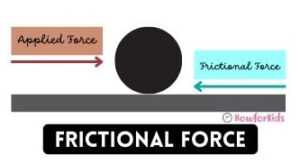
Frictional Force: Definition
Friction or frictional force is a contact force. It can put resistance and oppose the movement of a body. When you ride a bike and stop pedaling, you lose speed until the bike stops. This is because a contact force called friction is acting. It is the one that is exerted by the contact or friction of the wheels of your bicycle against the ground.
Weight as Force at Distance
What is Weight?
Weight is also a force. Weight of a body is called the attractive force exerted by Earth’s gravity on it. The greater the mass of a body, the greater the attraction exerted by the earth’s gravity and the greater its weight. The force of gravity acts at a distance and is responsible for the weight of all bodies. The weight of a body is directly proportional to its mass.
Mass and Weight
What is the Difference Between Weight and Mass
We must not confuse the mass with weight.
The mass depends on the amount of matter that the body has, and it is constant.
The weight of a body varies with gravity, the greater the gravity, the greater the weight. The weight on Earth is not the same as the weight on the Moon or on another planet because they have different gravity.
We constantly observe objects moving around us. Movement is one of the most obvious physical phenomena because it is easy to observe. The movement is relative, it depends on the observer. The study of it allows us to understand the movement of objects such as trains, cars and planes. It is also used to study the movements in the universe (satellites, planets, stars).
Fun Facts about Motion and Forces for Kids
The ideas of the movement appeared through the observation of different phenomena. There were several ancient researchers who were in charge of studying the movement.
• Aristotle, Greek philosopher, (384-322 BC) believed that there were two types of movement: the natural movement of each object that depended on its constitution (earth, water, air, fire) and the violent movement that was due to pushing forces or traction applied. He held that the natural state of bodies was rest. They only moved if they were pushed.
• Until Galileo Galilei, (1564-1642) Italian astronomer, philosopher, physicist, mathematician, dedicated himself to experimenting with the movement and fall of bodies.
• Later, Isaac Newton (1642-1727) postulated the three laws of motion that explain why objects move.
• The branch of physics that studies movement is called mechanics. It is divided into two areas: Kinematics, which is the part that studies the laws of motion without taking into account the causes that have produced it. And dynamics, which is the part of Mechanics that explains the causes that produce movement, which are forces.
Newton’s Laws of Motion
- Newton’s first law tells us that an object will not change its motion unless acted on by a force.
- Newton’s second law tells us that heavier objects need a greater force to move them.
- Newton’s third law tells us that for every action (force) there is an equal and opposite reaction.
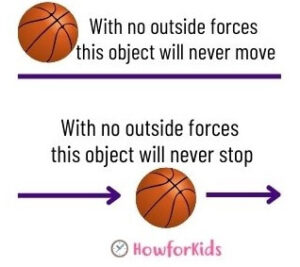
Force and Motion with Real Life Examples for Kids
Forces produce movement, they allow to change the position of a body, and modify the speed and direction of an object. A body moves when a force acts by changing its position with respect to a reference point that we consider to be fixed.
Any body in motion is called mobile.
What is Motion?
Movement is another effect that occurs when a force is applied.
State of the Movement with Examples
Different situations can happen that change the state of the movement:
1. An object that was at rest begins to move, initiates motion. (When you throw an object like a ball).
2. A moving object changes its trajectory, deflects motion. (For example, when you hit a ball that is in motion with a paddle).
3. A moving object changes how fast it moves. (For example, when the wind blows and a sailboat starts to sail faster on the water).
4. An object in motion becomes at rest, or stops the movement. (For example, when you catch a ball that is in motion).
Movement: Position, Trajectory, Distance and Displacement
Movement is the change of position of a body in a given time. To understand movement it is necessary to fix a reference point.
Cartesian coordinate system facts for kids
What are Coordinates: Explained for Primary School
The reference system in physics is very important when studying movements: It will be essential when establishing the position of the body studied.
A reference system is the place from which the position of a body is indicated at any time. It assumes the position of the observer with respect to the observed phenomenon.
In Physics, the system formed by the axes and the Cartesian coordinates is used as a reference system.
Position
It is the place where the body is found. To determine the position of a body we first establish the reference system. The observer is located at the origin of the reference system or initial position.
Trajectory
It is the path traveled by the object during its movement. If the trajectory is a straight line, the movement is called rectilinear and if it is a curve, it is curvilinear.
Distance
It is the space traveled by the object on the trajectory.
Displacement
It is the distance in a straight line between the initial and final position. It is the variation experienced by a mobile, between the starting point and the arrival point.
Distance and displacement are usually used as synonyms, as they actually have a different meaning.
The distance traveled is always measured on the trajectory, unlike the displacement, in which only the start and end point of the movement count. When the path is a straight line, the distance traveled is equal to the displacement.
Path Types
• Rectilinear: Rectilinear movement: The path followed by the object is in a straight line.
• Curvilinear: They can be circular, elliptical, parabolic or irregular.
Difference Between Speed and Velocity
In physics speed and velocity are different. Although speed and velocity are often used interchangeably in everyday life, they represent different quantities in physics.
What is Speed?
Speed is a measurement of how fast an object moves relative to a reference point. It does not have a direction and is considered a magnitude or scalar quantity.

What is Velocity
Velocity is the rate of change in an object’s position. Velocity has a magnitude (speed) and a direction.
Dynamometer: types, working principle and power measurement basics
In our daily life we use scales to know the weight of objects. But scientists, in laboratories, use an instrument called a dynamometer. It is an instrument used to measure the intensity of a force. It is formed by a tube that contains a spring that stretches when a force is applied. When the force ceases, the spring returns to its original shape. One end of the spring is fixed, while the other end allows objects to be hung. It has a scale where you can measure the intensity of the force.

What is the dynamometer and what is it used for?
How does the Dynamometer work?
The dynamometer works by hanging an object or exerting a force on the external hook, the spring stretches and reaches a certain value on the numerical scale, indicating the value of the force. The greater the force, the more the spring stretches.
Who Invented the Dynamometer?
Isaac Newton, physicist and mathematician of English origin, was the one who invented the dynamometer. Forces are measured in a unit called a newton which is named after him in his honor. It was invented from the property that springs have to stretch proportionally to the weight that hangs. The spring is stretched by the force of gravity on the numerical scale where the weight is read. Remember that weight is a force.
What are Simple Machines?
Simple machines are made up of one or a few parts. They are devices that make our usual tasks easier. They have been invented to reduce the effort in everyday activities. They transform a small force into a large one or vice versa. Some modify the direction of the applied force. For example, they allow us to move objects more comfortably. The difference that they have with compound machines, that compound machines are made up of various parts (such as motors, electrical circuits). Examples of simple machines are: Pulleys, levers, the inclined plane, the wheel.
Wheel and Axle
It is a round object or body that is disk-shaped and rotates around an axis. Each wheel is a simple machine. They can also be one more piece in a complex machine.
Pulley
It is a wheel, which is placed in a high place, and it has a slot through which a rope passes. It rotates on its axis. The object that needs to be lifted is placed on one end of the rope, and the force is applied on the other. It allows you to change the direction in which the force is applied, making it easier to lift heavy objects.
Lever
The lever is a rigid bar that moves on a fulcrum. At one end is the object to be moved. In the other a force is applied to lift it. Allow it to increase
the intensity of the force applied. Examples of levers are: bottle opener, scissors, seesaw, wheelbarrow. Two forces are distinguished in the lever:
– Power: is the force exerted to lift the object.
– Resistance: It is exerted by the object we want to lift.
Inclined Plane: The inclined plane is a ramp (inclined surface with a certain angle above the horizontal), used to raise and lower heavy weights with little effort. It decreases the force needed to lift a body